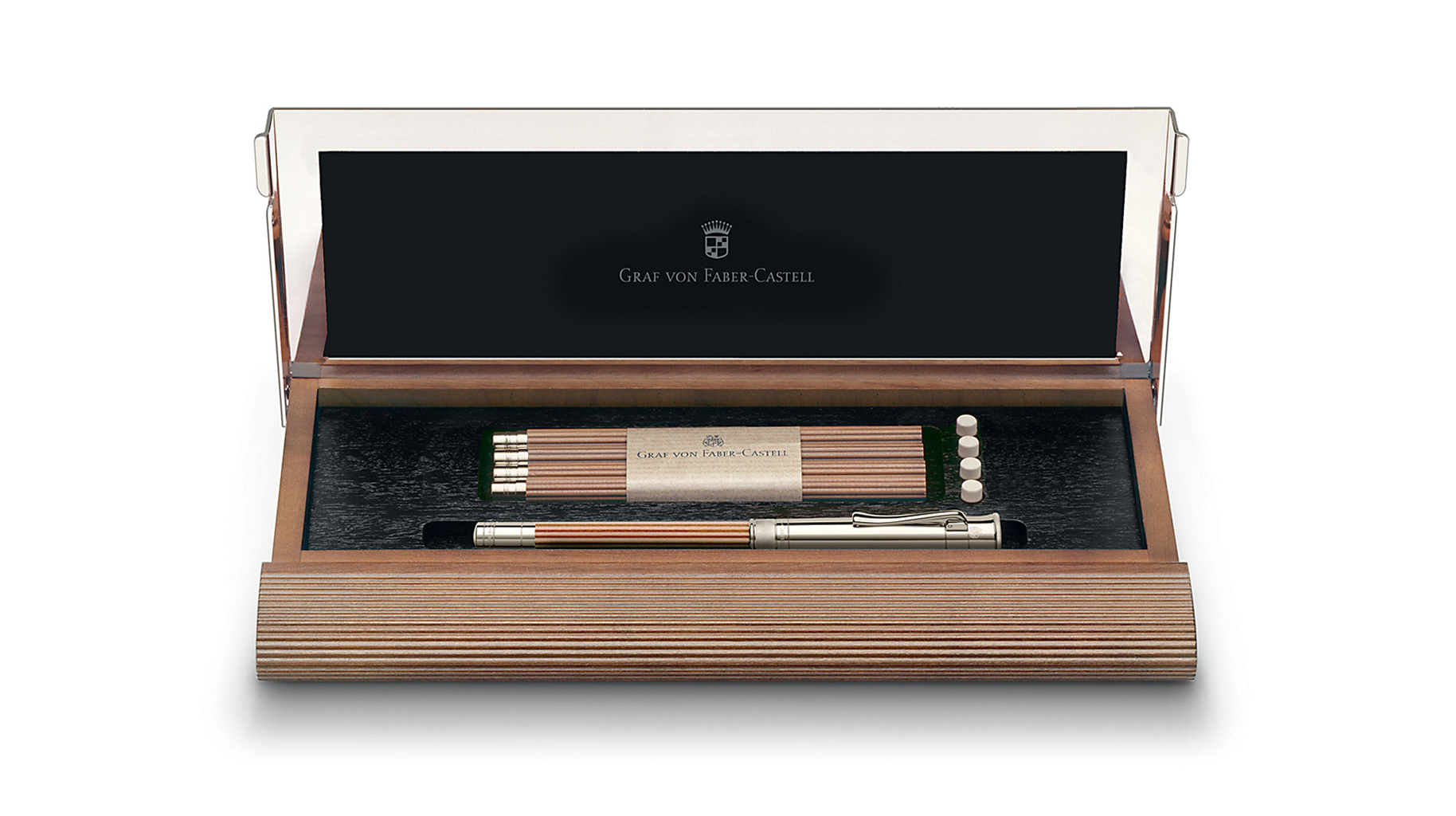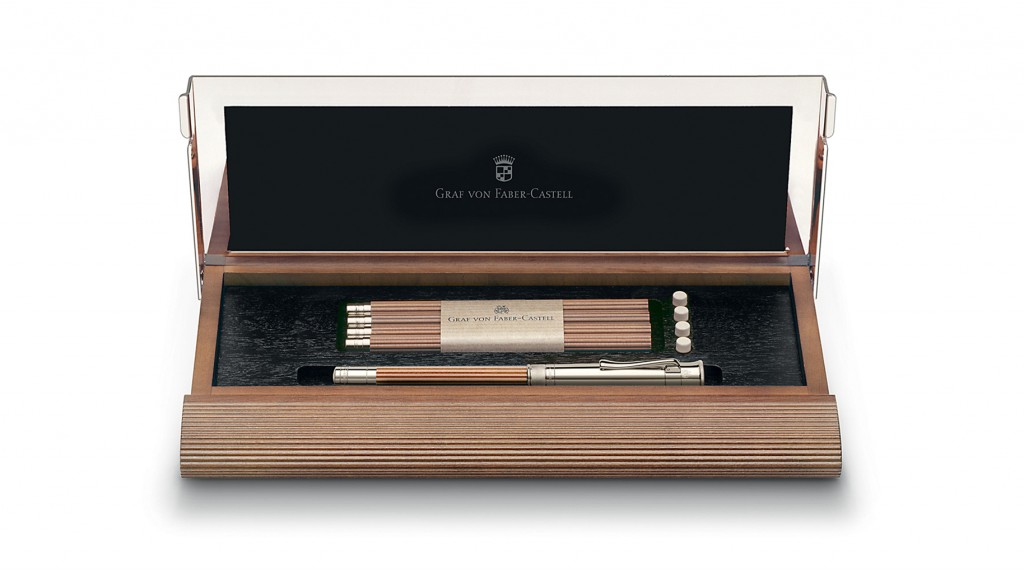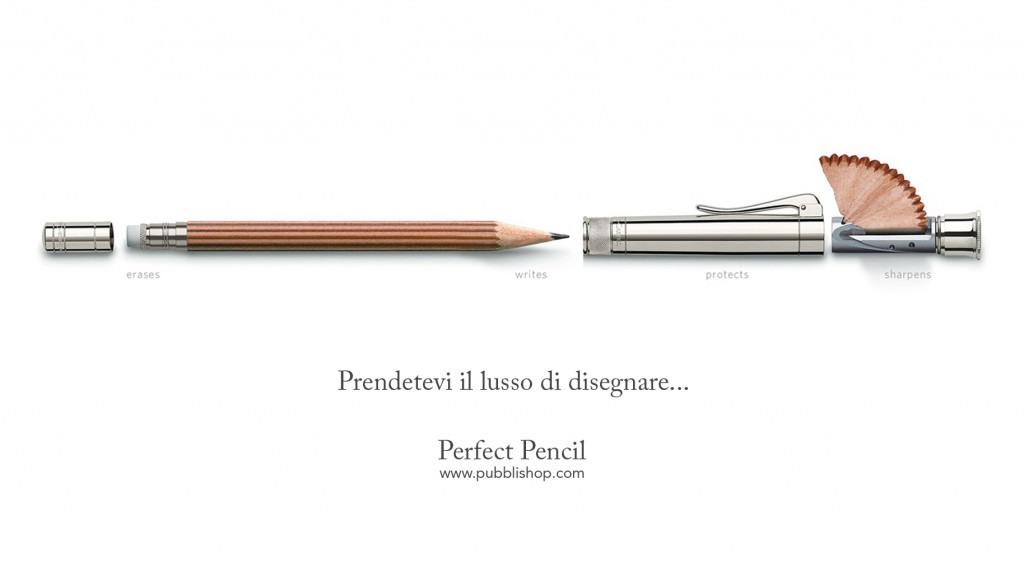Il tempo più prezioso dedichiamolo a noi, concediamoci il piacere delle belle cose e riscopriamo le nostre fanciullesche emozioni.
Le matite Graf von Faber-Castell rappresentano l’eccellenza delle matite di grafite. Il legno di Cedro Californiano, ideale per ottenere una affilatura perfetta e la la superficie scanalata rappresentano qualcosa di molto speciale.
Legno di ontano selezionato, legno preferito dagli artigiani scultori di Norimberga. Coperchio in metallo. Contiene una Matita Perfetta platinum-plated, quattro matite di ricambio e quattro gommini di ricambio.
L’allungalapis con il temperamatite incorporato occupa una speciale posizione nella collezione. Grazie poi alla gomma sostituibile sotto il fondello ecco un unico strumento compatto sempre pronto all’uso: per scrivere, cancellare e temperare.
L’allungalapis in platinum-plated o in argento massiccio (925/1000) con il temperamatite incorporato completa la matita. Quando é abbinato ad una matita dotata di gomma avete tutto ciò che vi occorre per scrivere, correggere e appuntire.
Faber-Castell. Il segno dell’eccellenza
È nel 1761 che Kaspar Faber, umile maestro artigiano, apre una propria bottega a Stein, land della Baviera, dove l’azienda ha tutt’oggi il suo quartier generale. Sono trascorsi 250 anni e Faber-Castell è ancora il primo produttore al mondo di matite di grafite e colorate. Chi impresse una svolta determinante all’impresa familiare portandola verso la modernizzazione fu Lothar Faber, bisnipote del fondatore, educato per volere del padre Leonhard nelle migliori scuole di Londra e Parigi per il ruolo di dirigente che gli competerà alla sua successione. Fu fautore della tecnologia più avanzata, sempre alla ricerca della migliore grafite, con un occhio attento al sociale e alle condizioni di vita dei suoi dipendenti. Durante la Guerra Civile Americana apre una fabbrica a Brooklyn, per favorire il commercio che il conflitto bellico aveva reso complicato. Nel 1862 gli fu conferito il titolo nobiliare dal re Massimiliano II di Baviera. Inventa la matita esagonale che diverrà famosa in tutto il mondo, e dal 1864 inizia a marchiare tutti i suoi prodotti A.W. Faber. Fu in seguito alla prematura scomparsa del figlio Wilhelm ed al matrimonio della nipote Ottilie col conte Alexander zu Castell-Rüdenhausen, discendente di una delle più blasonate famiglie dell’aristocrazia tedesca, che l’azienda prese il nome di Faber-Castell. Alla sua guida subentrò il conte Alexander, ruolo che manterrà anche dopo la separazione da Ottilie. Tra le nuove produzioni volute dal conte, ancor oggi in catalogo e vanto per l’azienda, si ricordano la matita Castell 9000, a cui dà il suo nome, verniciata in verde scuro, colore della sua uniforme, con stampigliato lo stemma della casata; nonché le matite colorate Polychromos, rivolte al mercato dell’arte. Nel 1928 gli succede il figlio maggiore Roland avuto dal matrimonio con Ottilie: sarà a capo dell’azienda per 50 anni. Roland costruisce nuove fabbriche e alle filiali in Brasile e Stati Uniti – che gli saranno confiscate nella II Guerra Mondiale, ma delle quali riacquisirà la maggioranza delle quote – aggiunge quelle in Australia, Perù, Argentina e Austria. Nel 1948 brevetta il portamine TK divenendo in breve famoso in tutto il mondo e apprezzato da artisti e illustratori. La Faber-Castell fu anche la prima azienda tedesca a produrre penne a sfera, che nel dopoguerra il pubblico preferirà alla stilografica, perché simbolo di modernità e cambiamento. Nel 1978, alla morte del padre il conte Anton Wolfgang von Faber-Castell eredita l’azienda e nuove sedi vengono aperte nel mondo, tra le quali quella in Malesia oggi la più grande del Gruppo. L’impronta del conte è per una strategia ecosostenibile: viene iniziato il primo progetto al mondo di riforestazione in Brasile, e pensata una moderna tecnologia a base d’acqua per la verniciatura dei fusti delle matite. Sono tante le vicende belle e anche dolorose che la famiglia ha affrontato nei 250 anni di storia dell’azienda, sempre sotto il “segno” di una qualità assoluta che si tramanda da generazioni, e che ha reso Faber-Castell sinonimo di eccellenza.
Let’s dedicate our precious time for ourselves and appreciate the pleasures of the valuable things by rediscovering our youthful emotions.
Graf von Faber-Castell pencils represent the culmination of the art of graphite writing. Californian cedar wood, which is ideal for neat sharpening and an attractive finely fluted surface indicate something special.
Selected native alder, favoured by the Nuremberg woodcarvers
Heavyweight metal lid
The cases are filled with a platinum-plated Perfect Pencil, four replacement pocket pencils and four spare erasers
The pencil extender with integrated sharpener occupies a special position in our collection. Together with the replaceable eraser under the pencil’s cap, everything is always quickly accessible within the smallest space – for writing, correcting and sharpening.
The platinum-plated or sterling silver (925/1000) pencil extender with a built-in sharpener is a perfect adjunct to the pencil. When used with a pencil that has an eraser under the cap, you have everything you need at the ready: for writing, correcting, and sharpening.
It is in 1761 that Kaspar Faber, humble artisan, lays the foundation of his own workshop in Stein, Bavaria, where the company still has its headquarters. It has been 250 years and “Faber-Castell” is still considered the first manufacturing company in the world of graphite and coloured pencils.
Lothar Faber, great-grandson of the founder, was the one to mark an important turning point to the family enterprise by leading it to a new modernisation. He attended the best schools of London and Paris to fulfill his father Leonhard’s will to take over the leadership of the company after him.
He was a supporter of the most advanced technology and he had always looked for the best graphite to use in his products. Still, he never forgot to take into consideration the social issues of his employees and their state of life.
In order to support national trading, which was being extremely affected by the American Civil War, Lothar Faber founds a factory in Brooklyn.
In 1862 King Maximilian II of Bavaria grants him the noble status.
He then invents the hexagonal pencil which will eventually become famous around the world.
In 1864 he starts labeling all his products “A.W. Faber”.
The company took the “Faber-Castell” name after the premature passing of Faber’s son Willhelm and the wedding between his granddaughter Ottilie with Count Alexander zu Castell-Rüdenhausen, heir of one of the most noble families of the German aristocracy. Count Alexander himself took the leadership of the company and he kept it even after his separation from Ottilie.
Among the new productions that the Count commissioned, one in particular is still in stock nowadays and still remains a source of pride for the company. The “Castell 9000” pencil, named after him, is painted in dark green, which was the same colour of his uniform, and it is labeled with the family emblem.
One can also mention the “Polychromos” coloured pencils, particularly addressed to the arts market.
In 1928 his eldest son Roland (from his marriage with Ottilie) takes the lead and keeps it for the following 50 years. Roland founds new factories and, besides the ones in Brazil and in the US – which will be confiscated during the Second World War but from which he will still manage to purchase again the majority of its shares – he adds other factories in Australia, Peru, Argentina and Austria.
In 1948 he patents the leadholder TK which will be internationally famous and esteemed by artists and illustrators.
“Faber-Castell” was also one of the first German companies to create the ballpoint pens, which in the postwar period will be more appreciated than the previously used fountain pens, symbolizing a phase of innovation and improvement.
In 1978, after the death of his father, Count Anton Wolfgang von Faber-Castell heirs the family company and founds new branches around the world, including the current biggest one located in Malaysia.
The count changes his mind set into a more sustainable ideology: he initiates the very first reforestation project of the world in Brazil, and develops a new technology that uses water to paint the frame of the pencils.
A lot of good and bad happens to the Faber-Castell family in their 250 years history, but they have always stood out by the excellent quality of their work which has been passed on from generation to generation making the “Faber-Castell” brand a synonym for excellence.



